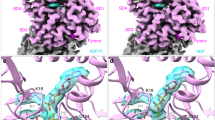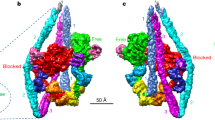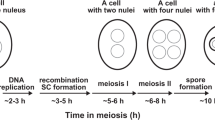Abstract
AMOEBA actin, a protein that shares many of the chemical, physical, and ultrastructural properties of muscle actin, has recently been isolated from Acanthamoeba castellanii1,2. The final steps in the purification procedure are the sedimentation of polymerized amoeba F-actin, its depolymerization by prolonged dialysis against a solution of ATP, and separation by molecular filtration on ‘Sephadex G-200’ of a minor excluded fraction and a major included fraction (amoeba G-actin). The product is monodisperse as judged by sedimentation equilibrium centrifugation in 5 M guanidine1 and has a molecular weight of about 39,500. Polyacrylamide gel electrophoresis at pH. 9.5 in 8.5 M urea of the reduced, carboxymethylated protein shows one major band that accounts for more than 90 per cent of the stainable protein. The amino-acid composition of amoeba actin was found to be very similar to that of other act ins including approximately 1 mole of the rare amino-acid 3-methylhistidine (3-MH) per mole of protein1. In addition, an unidentified component was detected which had the same elution time as ε-N-methyllysine in the chromatographic system used1 which does not separate monomethyllysine from dimethyllysine.
This is a preview of subscription content, access via your institution
Access options
Subscribe to this journal
Receive 51 print issues and online access
$199.00 per year
only $3.90 per issue
Buy this article
- Purchase on Springer Link
- Instant access to full article PDF
Prices may be subject to local taxes which are calculated during checkout
Similar content being viewed by others
References
Weihing, R. R., and Korn, E. D., Biochem. Biophys. Res. Commun., 35, 906 (1969).
Pollard, T. D., Shelton, E., Weihing, R. R., and Korn, E. D., J. Mol. Biol., 50, 91 (1970).
Murray, K., Biochemistry, 3, 10 (1964).
Paik, W. K., and Kim, S., Biochem. Biophys. Res. Commun., 27, 479 (1967).
Hempel, K., Lange, H. W., and Birkofer, L., Naturwissenschaften, 55, 37 (1968).
Delange, R. J., Glazer, A. N., and Smith, E. L., J. Biol. Chem., 244, 1385 (1969).
Hardy, M. F., and Perry, S. V., Nature, 223, 300 (1969).
Huszar, G., and Elzinga, M., Nature, 223, 834 (1969).
Kuehl, W. M., and Adelstein, R. S., Biochem. Biophys. Res. Commun., 37, 59 (1969).
Ambler, R. P., and Rees, M. W., Nature, 184, 56 (1959).
Lowry, O. H., Rosebrough, N. J., Farr, A. L., and Randall, R. J., J. Biol. Chem., 193, 265 (1951).
Spackman, D. H., in Serum Proteins and the Dysproteinemias (edit. by Sunderman, F. W., and Sunderman, jun., F. W.), 166 (Lippincott Philadelphia, 1964).
Weisman, R. A., and Korn, E. D., Biochim. Biophys. Acta, 116, 229 (1966).
Murray, K., in The Nucleohistones (edit. by Bonner, J., and Ts'o, P. O. P.), (Holden-Day, San Francisco, 1964).
Author information
Authors and Affiliations
Rights and permissions
About this article
Cite this article
WEIHING, R., KORN, E. ε-N-Dimethyllysine in Amoeba Actin. Nature 227, 1263–1264 (1970). https://doi.org/10.1038/2271263a0
Received:
Revised:
Issue Date:
DOI: https://doi.org/10.1038/2271263a0
Comments
By submitting a comment you agree to abide by our Terms and Community Guidelines. If you find something abusive or that does not comply with our terms or guidelines please flag it as inappropriate.



